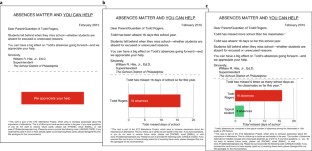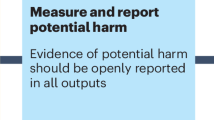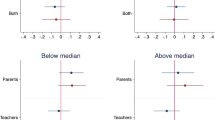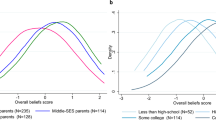Abstract
Student attendance is critical to educational success, and is increasingly the focus of educators, researchers and policymakers. We report the results of a randomized experiment examining interventions targeting student absenteeism. Parents of 28,080 high-risk students in grades kindergarten to 12th grade received one of three personalized information treatments repeatedly throughout the school year or received no additional information (control). The most effective versions reduced chronic absenteeism by 10% or more, partly by correcting parents’ biased beliefs about their children’s total accumulated absences. The intervention reduced student absences comparably across grade levels, and reduced absences among untreated cohabiting students in treated households. This intervention is easy to scale and is more than one order of magnitude more cost effective than current absence-reduction best practices. Educational interventions that inform and empower parents, such as the one reported here, can complement more intensive student-focused absenteeism interventions.
This is a preview of subscription content, access via your institution
Access options
Access Nature and 54 other Nature Portfolio journals
Get Nature+, our best-value online-access subscription
$29.99 / 30 days
cancel any time
Subscribe to this journal
Receive 12 digital issues and online access to articles
$119.00 per year
only $9.92 per issue
Buy this article
- Purchase on Springer Link
- Instant access to full article PDF
Prices may be subject to local taxes which are calculated during checkout



Similar content being viewed by others
References
Balfanz, R. & Byrnes, V. The Importance of Being in School: A Report on Absenteeism in the Nation’s Public Schools (Johns Hopkins Univ., 2012).
Gottfried, M. A. Evaluating the relationship between student attendance and achievement in urban elementary and middle schools: an instrumental variables approach. Am. Educ. Res. J. 47, 434–465 (2010).
Nauer, K., Mader, N., Robinson, G. & Jacobs, T. A Better Picture of Poverty: What Chronic Absenteeism and Risk Load Reveal About NYC’s Lowest Income Elementary Schools (Center for New York City Affairs, 2014).
Gershenson, S., Jacknowitz, A. & Brannegan, A. Are student absences worth the worry in US primary schools? Educ. Finance Policy 12, 137–165 (2017).
Allensworth, E. M. & Easton, J. Q. What Matters for Staying On-Track and Graduating in Chicago Public High Schools: a Close Look at Course Grades, Failures, and Attendance in the Freshman Year (Consortium on Chicago School Research, 2007).
Goodman, J. Flaking Out: Student Absences and Snow Days as Disruptions of Instructional Time Working Paper 20221 (National Bureau of Economic Research, 2014).
Gottfried, M. A. The detrimental effects of missing school: evidence from urban siblings. Am. J. Educ. 117, 147–182 (2011).
Byrnes, V. & Reyna, R. Summary of State Level Analysis of Early Warning Indicators (Johns Hopkins Univ., 2012).
Schoeneberger, J. Longitudinal attendance patterns: developing high school dropouts. Clearing House 85, 7–14 (2012).
Henry, K. L. & Thornberry, T. P. Truancy and escalation of substance use during adolescence. J. Stud. Alcohol Drugs 71, 115–124 (2010).
Baker, M. L., Sigmon, J. N. & Nugent, M. E. Truancy Reduction: Keeping Students in School (US Department of Justice, 2001).
Jacob, B. A. & Lefgren, L. Are idle hands the devil’s workshop? Incapacitation, concentration, and juvenile crime. Am. Econ. Rev. 93, 1560–1577 (2003).
Rohrman, D. Combating truancy in our schools—a community effort. NASSP Bull. 77, 40–45 (1993).
Ely, T. L. & Fermanich, M. L. Learning to count: school finance formula count methods and attendance-related student outcomes. J. Educ. Financ. 38, 343–369 (2013).
Every Student Succeeds Act (ESSA) (US Department of Education, 2015).
Lynch, L., Burwell, S., Castro, J. & Duncan, A. Joint Letter on Chronic Absenteeism (2015); http://www2.ed.gov/policy/elsec/guid/secletter/151007.html
Guryan, J. et al. The Effect of Mentoring on School Attendance and Academic Outcomes: a Randomized Evaluation of the Check and Connect Program Working Paper-16-18 (Northwestern Univ. Institute for Policy Research, 2017).
Sutphen, R. D., Ford, J. P. & Flaherty, C. Truancy interventions: a review of the research literature. Res. Social Work Pract. 20, 161–171 (2010).
O’Donnell, C. L. Defining, conceptualizing, and measuring fidelity of implementation and its relationship to outcomes in K–12 curriculum intervention research. Rev. Educ. Res. 78, 33–84 (2008).
Chugh, D. & Bazerman, M. H. Bounded awareness: what you fail to see can hurt you. Mind Soc. 6, 1–18 (2007).
Simons, D. J. & Chabris, C. F. Gorillas in our midst: sustained inattentional blindness for dynamic events. Perception 28, 1059–1074 (1999).
Sedikides, C., Gaertner, L. & Toguchi, Y. Pancultural self-enhancement. J. Pers. Soc. Psychol. 84, 60–79 (2003).
Lee, J. Y. Garrison Keillor: A Voice of America (Univ. Press Mississippi, Jackson, MS, 1991).
Kling, J. R., Mullainathan, S., Shafir, E., Vermeulen, L. & Wrobel, M. Comparison Friction: Experimental Evidence from Medicare Drug Plans Working Paper 17410 (National Bureau of Economic Research, 2012).
Grubb, M. D. & Osborne, M. Cellular service demand: biased beliefs, learning, and bill shock. Am. Econ. Rev. 105, 234–271 (2015).
Becker, G. S. A theory of social interactions. J. Political Econ. 82, 1063–1093 (1974).
Heckman, J. J. & Mosso, S. The Economics of Human Development and Social Mobility Working Paper 19925 (National Bureau of Economic Research, 2014).
Bursztyn, L. & Coffman, L. C. The school decision: family preferences, intergenerational conflict, and moral hazard in the Brazilian favelas. J. Political Econ. 120, 359–397 (2011).
Hastings, J. S. & Weinstein, J. M. Information, School Choice, and Academic Achievement: Evidence from Two Experiments Working Paper 13623 (National Bureau of Economic Research, 2007).
Bergman, P. Parent–Child Information Frictions and Human Capital Investment: Evidence from a Field Experiment (Columbia Univ., 2015); http://www.columbia.edu/~psb2101/BergmanSubmission.pdf
Bergman, P. & Rogers, T. The Impact of Defaults on Technology Adoption, and its Underappreciation by Policymakers Faculty Research Working Paper Series RWP17-021 (Harvard Kennedy School, Cambridge, MA, 2017).
Kraft, M. A. & Rogers, T. The underutilized potential of teacher-to-parent communication: evidence from a field experiment. Econ. Educ. Rev. 47, 49–63 (2015).
Frey, B. S. & Meier, S. Social comparisons and pro-social behavior: testing “conditional cooperation” in a field experiment. Am. Econ. Rev. 94, 1717–1722 (2004).
Shang, J. & Croson, R. A field experiment in charitable contribution: the impact of social information on the voluntary provision of public goods. Econ. J. 119, 1422–1439 (2009).
Ferraro, P. J., Miranda, J. J. & Price, M. K. The persistence of treatment effects with norm-based policy instruments: evidence from a randomized environmental policy experiment. Am. Econ. Rev. 101, 318–322 (2011).
Ferraro, P. J. & Price, M. K. Using nonpecuniary strategies to influence behavior: evidence from a large-scale field experiment. Rev. Econ. Stat. 95, 64–73 (2013).
Goldstein, N. J. & Cialdini, R. B. in Social Psychology of Consumer Behavior (ed. Wänke, M.) 273–296 (Psychology Press, New York, NY, 2009).
Allcott, H. & Rogers, T. The short-run and long-run effects of behavioral interventions: experimental evidence from energy conservation. Am. Econ. Rev. 104, 3003–3037 (2014).
Nolan, J. M., Schultz, P. W., Cialdini, R. B., Goldstein, N. J. & Griskevicius, V. Normative social influence is underdetected. Pers. Soc. Psychol. Bull. 34, 913–923 (2008).
Schultz, P. W., Nolan, J. M., Cialdini, R. B., Goldstein, N. J. & Griskevicius, V. The constructive, destructive, and reconstructive power of social norms. Psychol. Sci. 18, 429–434 (2007).
Coffman, L. C., Featherstone, C. R. & Kessler, J. B. Can social information affect what job you choose and keep? Am. Econ. J. Appl. Econ. 9, 96–117 (2017).
Gerber, A. S. & Rogers, T. Descriptive social norms and motivation to vote: everybody’s voting and so should you. J. Polit. 71, 178–191 (2009).
Keane, L. D. & Nickerson, D. W. When reports depress rather than inspire: a field experiment using age cohorts as reference groups. J. Political Mark. 14, 381–390 (2015).
Rogers, T., Green, D. P., Ternovski, J. & Young, C. F. Social pressure and voting: a field experiment conducted in a high-salience election. Elect. Stud. 46, 87–100 (2017).
Karlan, D., McConnell, M., Mullainathan, S. & Zinman, J. Getting to the top of mind: how reminders increase saving. Manag. Sci. 62, 3393–3411 (2016).
Balfanz, R. & Byrnes, V. Meeting the Challenge of Combating Chronic Absenteeism (Johns Hopkins Univ., 2013).
Balu, R., Porter, K. & Gunton, B. Can Informing Parents Help High School Students Show Up for School? (MDRC, 2016).
Allcott, H. Social norms and energy conservation. J. Public Econ. 95, 1082–1095 (2011).
Rogers, T. & Feller, A. Discouraged by peer excellence: exposure to exemplary peer performance causes quitting. Psychol. Sci. 27, 365–374 (2016).
Beshears, J., Choi, J. J., Laibson, D., Madrian, B. C. & Milkman, K. L. The effect of providing peer information on retirement savings decisions. J. Finance 70, 1161–1201 (2015).
Nickerson, D. W. Is voting contagious? Evidence from two field experiments. Am. Political Sci. Rev. 102, 49–57 (2008).
Goetzel, R. Z., Hawkins, K., Ozminkowski, R. J. & Wang, S. The health and productivity cost burden of the “top 10” physical and mental health conditions affecting six large US employers in 1999. J. Occup. Environ. Med. 45, 5–14 (2003).
Ten Brummelhuis, L. L., Johns, G., Lyons, B. J. & ter Hoeven, C. Why and when do employees imitate the absenteeism of co-workers? Organ. Behav. Hum. Decis. Process. 134, 16–30 (2016).
Robinson, K. & Harris, A. L. The broken compass: parental involvement with children’s education. J. Educ. Res. 108, 345–346 (2014).
Valencia, R. R. The Evolution of Deficit Thinking: Educational Thought and Practice (Falmer Press, Bristol, PA, 1997).
Henderson, A. T. & Mapp, K. L. A New Wave of Evidence: The Impact of School, Family, and Community Connections on Student Achievement (National Center for Family and Community Connections with Schools, 2002).
Rosenbaum, P. R. Observational Studies 1–17 (Springer, New York, NY, 2002).
Acknowledgements
We thank the Laura and John Arnold Foundation, Pershing Square Venture Fund for Research on the Foundations of Human Behavior and IES/ICF/REL MidAtlantic number 14JTSK0003 for funding support. We thank J. Lasky-Fink, J. Ternovski and S. Subramanyam for research support. We thank T. Wolford, A. Reitano and W. Hite for district partnership and collaboration. We thank B. Balfanz, G. Basse, M. Bazerman, P. Bergman, H. Chang, L. Coffman, D. Deming, C. Fox, H. Gehlbach, A. Gelber, F. Gino, E. Glaeser, M. Gottfried, D. Green, H. Hoynes, L. John, G. King, D. Laibson, M. Laitin, S. Mullainathan, M. Norton, L. Page, L. Pierce, S. Reardon and J. Schwartzstein for feedback on earlier drafts. No funders had any role in study design, data collection and analysis, decision to publish or preparation of the manuscript.
Author information
Authors and Affiliations
Contributions
T.R. and A.F. designed the experiment, oversaw data analysis and wrote the manuscript.
Corresponding author
Ethics declarations
Competing interests
The authors declare that they had no competing financial interests while this project was being conducted. In the light of the results of this and other projects, T.R. and A.F. started an organization to help US schools implement this intervention to reduce student absenteeism. It is called In Class Today and worked with two school districts at the time of initial submission, including the school district in which the experiment reported in this manuscript was conducted—SDP.
Additional information
Publisher’s note: Springer Nature remains neutral with regard to jurisdictional claims in published maps and institutional affiliations.
Supplementary information
Supplementary Information
Supplementary Notes, Supplementary Methods, Supplementary Tables 1–28, Supplementary Discussion, Supplementary Figures A–D
Rights and permissions
About this article
Cite this article
Rogers, T., Feller, A. Reducing student absences at scale by targeting parents’ misbeliefs. Nat Hum Behav 2, 335–342 (2018). https://doi.org/10.1038/s41562-018-0328-1
Received:
Accepted:
Published:
Issue Date:
DOI: https://doi.org/10.1038/s41562-018-0328-1
This article is cited by
-
Randomized design evidence of the attendance benefits of the EPA School Bus Rebate Program
Nature Sustainability (2023)
-
A Latent Class Analysis of Mental Health Symptoms in Primary School Children: Exploring Associations with School Attendance Problems
School Mental Health (2023)
-
Experimental evidence on learning using low-tech when school is out
Nature Human Behaviour (2022)
-
The Role of Clearinghouses in Promoting Transparent Research: A Methodological Study of Transparency Practices for Preventive Interventions
Prevention Science (2022)
-
Associations Between Developmental Risk Profiles, Mental Disorders, and Student Absences Among Primary and Secondary Students in Australia
School Mental Health (2021)



